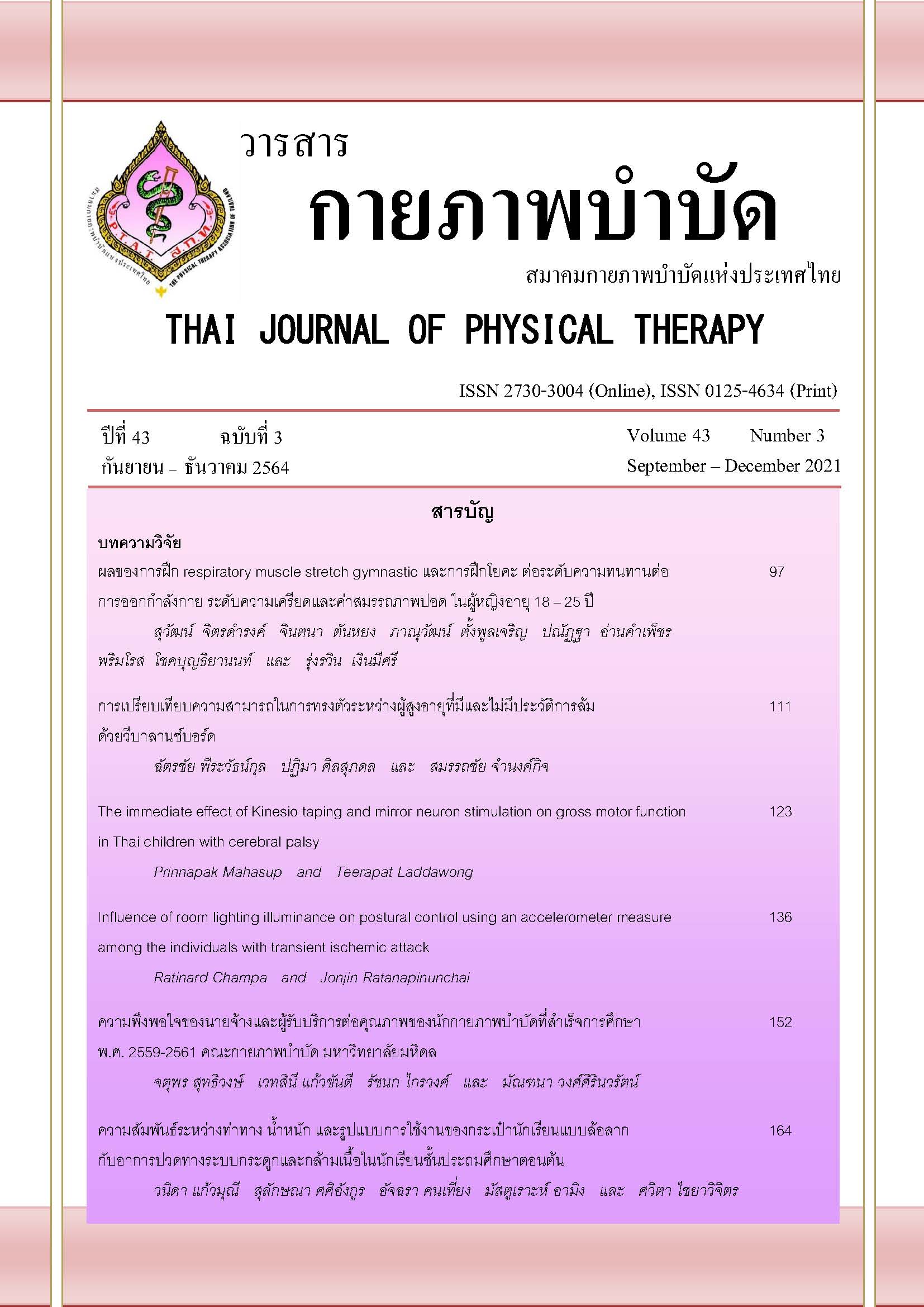ความสัมพันธ์ระหว่างท่าทาง น้ำหนัก และรูปแบบการใช้งานของกระเป๋านักเรียนแบบล้อลากกับอาการปวดทางระบบกระดูกและกล้ามเนื้อในนักเรียนชั้นประถมศึกษาตอนต้น
Main Article Content
บทคัดย่อ
ที่มาและความสำคัญ: กระเป๋านักเรียนแบบล้อลากถูกพัฒนาขึ้นแทนการสะพายหรือถือ เพื่อลดปัญหาอาการปวดของระบบกระดูกและกล้ามเนื้อ อย่างไรก็ตามด้วยรูปแบบการใช้งานกระเป๋าดังกล่าวยังมีโอกาสที่นักเรียนเลือกถือหรือสะพายแทนการลากได้ ซึ่งอาจส่งผลให้เกิดอาการปวดทางระบบกระดูกและกล้ามเนื้อตามมา
วัตถุประสงค์: เพื่อศึกษาความสัมพันธ์ระหว่างท่าทาง น้ำหนัก และรูปแบบการใช้งานของกระเป๋านักเรียนแบบล้อลากกับอาการปวดทางระบบกระดูกและกล้ามเนื้อในนักเรียนชั้นประถมศึกษาตอนต้น
วิธีการวิจัย: การศึกษานี้เป็นการศึกษาเชิงพรรณนาแบบภาคตัดขวาง ในนักเรียนขั้นประถมศึกษาปีที่ 1-3 ที่มีการใช้งานกระเป๋านักเรียนแบบล้อลากจำนวน 72 คน โดยประเมินตำแหน่งของอาการปวด ระดับอาการปวด ท่าทางการใช้งานกระเป๋านักเรียน รูปแบบการใช้งานกระเป๋านักเรียน (ลาก-ถือ-สะพาย) และน้ำหนักกระเป๋านักเรียน
ผลการวิจัย: น้ำหนักกระเป๋านักเรียน น้ำหนักกระเป๋านักเรียนต่อน้ำหนักตัว และรูปแบบการใช้งานขึ้น-ลงรถ มีความสัมพันธ์อย่างมีนัยสำคัญทางสถิติกับอาการปวด ค่า p-value เท่ากับ 0.04, 0.013 และ 0.014 ตามลำดับ ในขณะที่ท่าทางและรูปแบบการใช้งานอื่นกับอาการปวดไม่พบความสัมพันธ์กัน
สรุปผล: รูปแบบใช้งานขึ้น-ลงรถ น้ำหนักของกระเป๋านักเรียนแบบล้อลาก ตลอดจนร้อยละน้ำหนักกระเป๋าต่อน้ำหนักตัวส่งผลให้เกิดอาการปวดทางระบบกระดูกและกล้ามเนื้อในนักเรียนขั้นประถมศึกษาตอนต้นได้
Article Details
เอกสารอ้างอิง
Brackley HM, Stevenson JM. Are Children’s Backpack Weight Limits Enough? A Critical Review of the Relevant Literature. Spine. 2004;29(19):2184–90.
Ruttanaseeha W, Sahunin A, Supad P, Chuasathuchon P, Thanetphonkul R, Techabunyarat R, et al. Study of weight excess of year 1-4 students’ school bags at Khon Kaen university primary demonstration school. Srinagarind Med J. 2009;24(1):2–8.
Dianat I, Javadivala Z, Allahverdipour H. School bag weight and the occurrence of shoulder, hand/wrist and low back symptoms among Iranian elementary schoolchildren. Health Promot Perspect. 2011;1(1):76–85.
Khan R, Jabeen H, Arshad HS. Neck, shoulder, and back pain with carrying heavy back packs among the spirit school children in Lahore. Int J Sci Res. 2016;5(6):397–400.
Shamsoddini A, Hollisaz M, Hafezi R. Backpack weight and musculoskeletal symptoms in secondary school students, Tehran, Iran. Iranian J Publ Health. 2010;39(4): 120–5.
Deesungnern S, Thawinchai N. A survey of factors associated with schoolbag carrying and pain during schoolbag usage in high school students of Darawittayalai school. Thai J Phys Ther. 2014;36(2):70–8.
Arghavani F, Zamanian Z, Ghanbary A, Hassanzade J. Investigation of the relationship between carrying school bags (handbags and backpacks) and the prevalence of musculoskeletal pains among 12-15 years old students in Shiraz. Pak J Biol Sci. 2014;17(4): 550–4.
Al-Hazzaa HM. How much load do Saudi school boys carry on their shoulders? Saudi Med J. 2006;27(10):1567–71.
Forjuoh SN, Lane BL, Schuchmann JA. Percentage of Body Weight Carried by Students in Their School Backpacks: Am J Phys Med Rehabil. 2003;82(4):261–6.
Rontogiannis D, Tsaklis P, Mavromoustakos S, Kottaras S. Comparison between two different types of school bags and musculoskeletal symptoms in primary school students. IETI Trans Ergon Saf. 2017;1(2):11–21.
Orantes-Gonzalez E, Heredia-Jimenez J, Beneck GJ. Children require less gait kinematic adaptations to pull a trolley than to carry a backpack. Gait Posture. 2017;52:189–93.
Orantes-Gonzalez E, Heredia-Jimenez J. Pulling a school trolley: A good kinematic option for children. Gait Posture. 2017;53:61–6.
Cochran WG, Carroll SP. A Sampling Investigation of the Efficiency of Weighting Inversely as the Estimated Variance. Biometrics. 1953;9(4):447–59.
Vitayaburananont P, Chotisukarat H. Pediatric Pain. Vajira Med J. 2016;60(2):135–45.
Phalitpolkanpim A. Thai children carrying school bags Too heavy [Internet]. Child Safety Promotion and Injury Prevention Research Center (CSIP). [cited 2020 Aug 11]. Available from: http://csip.org/ebook/no17/page5.html
Delele M, Janakiraman B, Bekele Abebe A, Tafese A, van de Water ATM. Musculoskeletal pain and associated factors among Ethiopian elementary school children. BMC Musculoskelet Disord. 2018;19(276):1–8.
Gonzalez EO. The use of trollies and backpacks for load carriage in elementary school students: a biomechanical analysis and recommendations [Thesis]: University of Granada; 2018.
Polyong CP, Sarapimpha N, Deekla C, Phukkarawek S, Thepthong B, Poldongnok P. Effects of Upper Musculoskeletal Disorder from School Bag Usage among Primary School Grade 4-6 Students for a School in Bangkok Metropolis. J Dep Med Serv. 2019;44(4):48–53.
Orantes-Gonzalez E, Heredia-Jimenez J, Robinson MA. A kinematic comparison of gait with a backpack versus a trolley for load carriage in children. Appl Ergon. 2019;80:28–34.
Orantes-Gonzalez E, Heredia-Jimenez J. Does a standard school trolley fit children of different heights? Ergonomics. 2020;1–6.
Bettany-Saltikov J, Cole L. The effect of frontpacks, shoulder bags and handheld bags
on 3D back shape and posture in young university students: an ISIS2 study. Stud Health Technol Inform. 2012;176:117–21.
Massimiliano P, Bruno L, Maurizio P, Maury A. N. Characterization of pulling forces exerted by primary school children while carrying trolley bags. In: Proceedings of the Human Factors and Ergonomics Society Annual Meeting 2013. Los Angeles: SAGE Publications; 2013:501–5.


